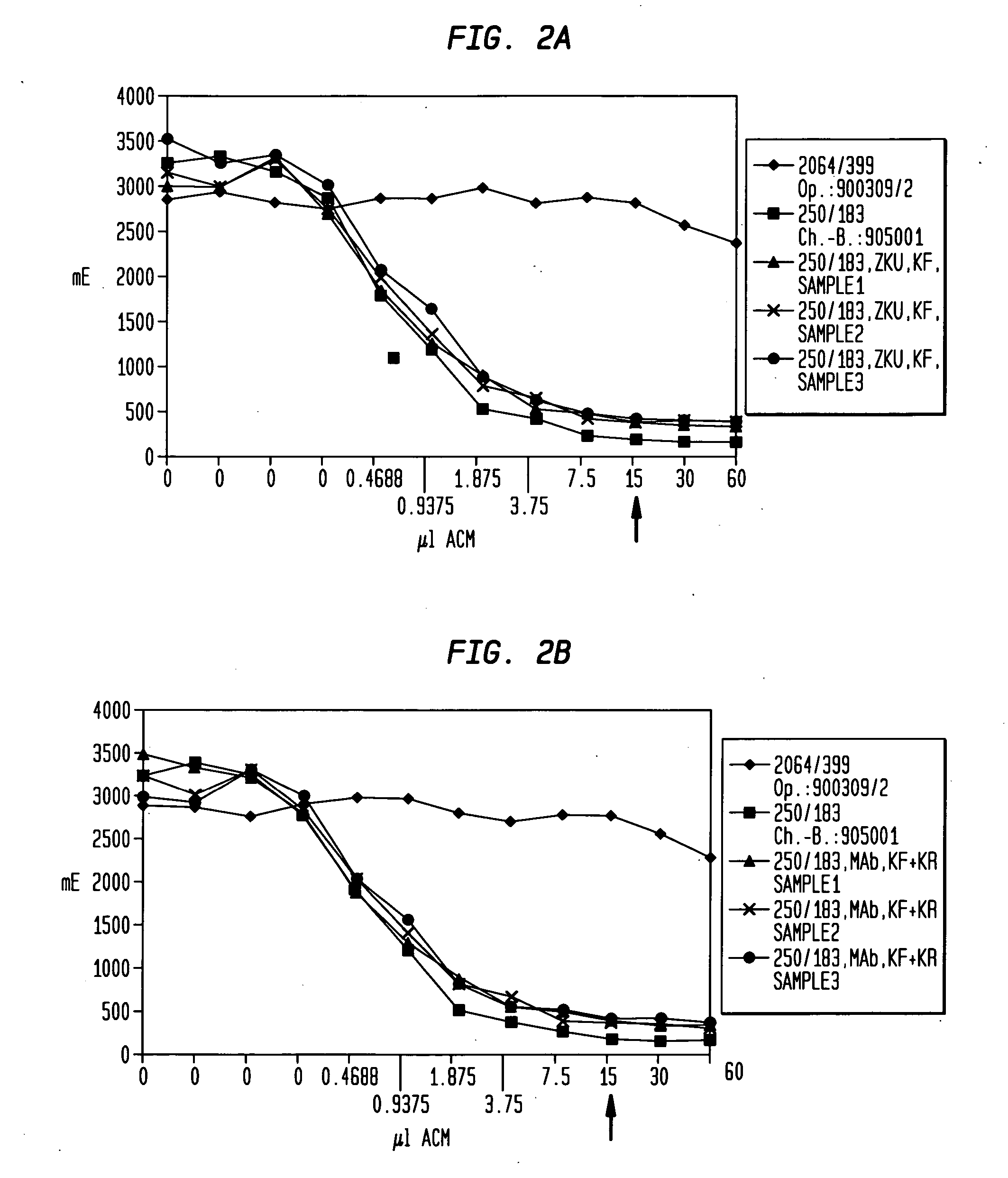Proteins with high immunoreactivity and method for their production
a protein and immunoreactivity technology, applied in the field of immunoreactive protein preparations, can solve the problems of complex fermentation system, unsuitable for determination of absolute immunoreactive fractions, and expensive culture media, and achieve high immunoreactivity values and economic efficiency
- Summary
- Abstract
- Description
- Claims
- Application Information
AI Technical Summary
Benefits of technology
Problems solved by technology
Method used
Image
Examples
example 1
[0073] This example is directed to the comparison of the immunoreactivity of Mab BW 250 / 183 (Eur. J. Nucl. Med. 14 (1988), 523-528) measured with the modified Lindmo-test (see Example 3 for method) at conventional fermentation and purification and the two new fermentation and purification procedures (production method I and production method II) described herein each prior to starting the purification (cell supernatant) and after ending the purification (purified Mab-end product).
[0074] The Mab-containing samples of the cell supernatants respectively the purified Mab-end products were treated, as exactly described in Example 3, and then undergo the modified Lindmo-test according to the prescribed protocol. An Mab from the identical isotype (IgG1) was used as a negative control having the same light chain (κ), a comparable isoelectric point and a non-relevant specificity. The positive control is a charge of a Mab BW 250 / 183 with an immunoreactivity of 91 to 94% purified with an anti...
example 2
[0101] Production Method I
[0102] Culturing Eukaryotic Cells and their Fermentation in a Fluidized Reactor
[0103] An ampoule from the working cell bank, stored in liquid nitrogen is being defrosted and the cells contained therein are cultivated under standard cell culture conditions (synthetic protein-free cell culture medium) in T-flasks. When a cell titer of 6-10×107 has been reached, the content of 4-6 T-flasks is further cultivated in a 500 ml—Spinner container under standard cell culture conditions. After reaching cell titer of 1.5-2×108, the cells are then transferred into 2 Spinner containers each of 1000 ml volume and cultivated further. After reaching a cell titer of 1.2-1.5×109, the cells are inoculated in a 900 ml cell culture medium and 200 ml SiranR-carrier containing fluidized reactor (Bioreactor Pilot B 500, Papaspyrou Biotechnologie GmbH, Technologiezentrum Jülich, D-52428 Jülich) and cultivated in accordance with the directions of the Papaspyrou Biotechnologie compa...
example 3
Modified Quantitative Immunoreactivity Test According to Lindmo
[0123] Introduction:
[0124] In order to determine the content of immunoreactive monoclonal antibodies in hybridoma supernatants, a binding assay with an excess amount of antigen in combination with a sensitive (1-2 ng mouse-Ig / ml) ELISA-system was used for the determination of the portion of unbound monoclonal antibodies. This test has essentially two advantages as compared with the immunoreactivity test developed by Lindmo, namely [0125] a) the test permits determining the immunoreactivity of un-purified as well as purified non-radio labeled and radio labeled Mab; and [0126] b) the test permits determining the immunoreactivity in the absence of unspecific binding.
[0127] Material
[0128] 1.1 Chemicals and Materials
NameManufacturerOrder No.Formaldehyde solution, 37%Merck818708Sodium dihydrogen-Merck 6346phosphate-1-hydrateDi-sodiumhydrogen-Merck 30412phosphate-2-hydratePBSBehringwerkeGlycinMerck10420196 well micro tit...
PUM
| Property | Measurement | Unit |
|---|---|---|
| diameter | aaaaa | aaaaa |
| affinity chromatography | aaaaa | aaaaa |
| affinity | aaaaa | aaaaa |
Abstract
Description
Claims
Application Information
 Login to View More
Login to View More - R&D
- Intellectual Property
- Life Sciences
- Materials
- Tech Scout
- Unparalleled Data Quality
- Higher Quality Content
- 60% Fewer Hallucinations
Browse by: Latest US Patents, China's latest patents, Technical Efficacy Thesaurus, Application Domain, Technology Topic, Popular Technical Reports.
© 2025 PatSnap. All rights reserved.Legal|Privacy policy|Modern Slavery Act Transparency Statement|Sitemap|About US| Contact US: help@patsnap.com



